VERY RARE! WWII Okinawa D-Day +8 Battle Report April 9th 1945 USS Colorado COA
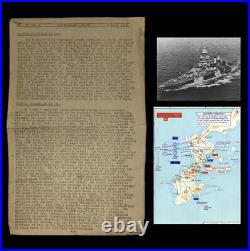

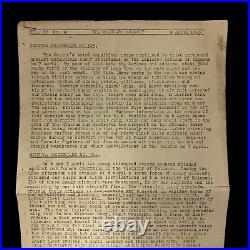
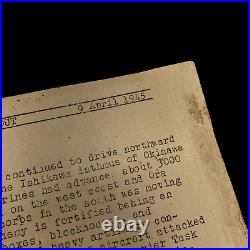
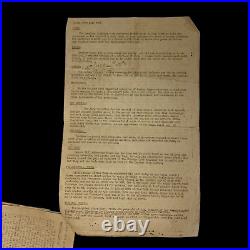
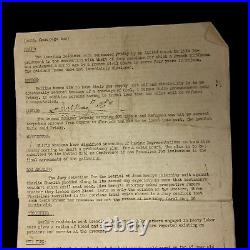
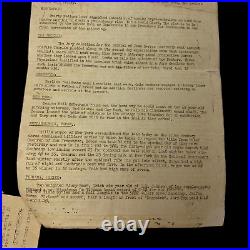

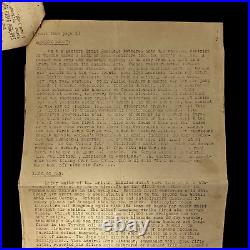
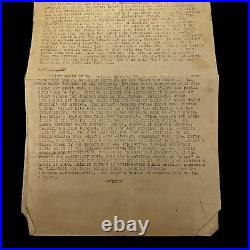
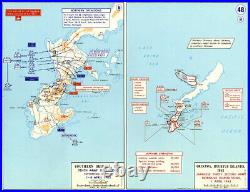
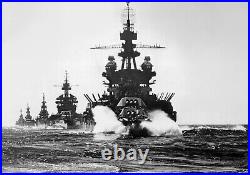

This USS Colorado combat report was printed on April 9th, 1945 with combat intelligence +8 days following the D-Day invasion of Okinawa on April 1st, 1945. During the invasion, the USS Colorado and the Fifth Fleet launched the largest bombardment ever to support a troop landing to soften Japanese defences. During the Battle of Okinawa, the Fifth Fleet suffered.
4,900 men killed or drowned. This incredibly rare and museum-grade artifact is an original April 9th, 1945 combat report from the USS Colorado (BB-45) as it provided air and bombardment support during the Invasion of Okinawa. He Battle of Okinawa codenamed Operation Iceberg.
Was a major battle of the. Fought on the island of. The initial invasion of Okinawa on 1 April 1945 was the largest. In the Pacific Theater of. This extremely detailed combat report has the newest battle intelligence of Operation Iceberg and details secret details of the exact number of USMC and Japanese casualties, advancement lines, resistance pockets, infantry division movements, and other various captured Japanese intelligence.
This report also details the 3rd Amphibious Marine Corps drive against Japanese resistance on Okinawa as well as carrier-based assaults, heavily artillery bombardments and other SECRET strategic offensives. It also heavily details the invasion details on April 6th and April 7th. Just a few days following the amphibious landings on the beaches. This multi-page combat intelligence report also details advancements and intelligence in the war against Germany in the European Theater.
The Battle of Okinawa (April 1, 1945-June 22, 1945) was the last major battle of World War II, and one of the bloodiest. On April 1, 1945-Easter Sunday-the Navy's Fifth Fleet and more than 180,000 U. Marine Corps troops descended on the Pacific island of Okinawa for a final push towards Japan. The invasion was part of Operation Iceberg, a complex plan to invade and occupy the Ryukyu Islands, including Okinawa. Though it resulted in an Allied victory, kamikaze fighters, rainy weather and fierce fighting on land, sea and air led to a large death toll on both sides.
By the time American troops landed on Okinawa, the war on the European front was nearing its end. Allied and Soviet troops had liberated much of German-occupied Europe and were just weeks away from forcing Germany's unconditional surrender. In the Pacific theater, however, American forces were still painstakingly conquering Japan's Home Islands, one after another.
After obliterating Japanese troops in the brutal Battle of Iwo Jima, they set their sights on the isolated island of Okinawa, their last stop before reaching Japan. Okinawa's 466 square miles of dense foliage, hills and trees made it the perfect location for the Japanese High Command's last stand to protect their motherland. They knew if Okinawa fell, so would Japan. The Americans knew securing Okinawa's airbases was critical to launching a successful Japanese invasion.
As dawn arrived on April 1, morale was low among American troops as the Fifth Fleet launched the largest bombardment ever to support a troop landing to soften Japanese defenses. Soldiers and Army brass alike expected the beach landings to be a massacre worse than D-Day. But the Fifth Fleet's offensive onslaught was almost pointless and landing troops could have literally swum to shore-surprisingly, the expected mass of awaiting Japanese troops wasn't there.On D-Day, American troops fought hard for every inch of beachhead-but troops landing on Okinawa's beaches surged inland with little resistance. Wave after wave of troops, tanks, ammunition and supplies went ashore almost effortlessly within hours. The troops quickly secured both Kadena and Yontan airfields. Japan's 32nd Army, some 130,000 men strong and commanded by Lt. The military force also included an unknown number of conscripted civilians and unarmed Home Guards known as.
As they moved inland, American troops wondered when and where they'd finally encounter enemy resistance. What they didn't know was the Japanese Imperial Army had them just where they wanted them.
Japanese troops had been instructed not to fire on the American landing forces but instead watch and wait for them, mostly in Shuri, a rugged area of southern Okinawa where General Ushijima had set up a triangle of defensive positions known as the Shuri Defense Line. American troops who headed North to the Motobu Peninsula endured intense resistance and over 1,000 casualties but won a decisive battle relatively quickly. It was different along the Shuri Line where they had to overcome a series of heavily defended hills loaded with firmly-entrenched Japanese troops. On April 7, Japan's mighty battleship Yamato was sent to launch a surprise attack on the Fifth Fleet and then annihilate American troops pinned down near the Shuri Line.But Allied submarines spotted the. And alerted the fleet who then launched a crippling air attack. After the Americans cleared a series of outposts surrounding the Shuri Line, they fought many fierce battles including clashes on Kakazu Ridge, Sugar Loaf Hill, Horseshoe Ridge and Half Moon Hill. Torrential rains made the hills and roads watery graveyards of unburied bodies. Casualties were enormous on both sides by the time the Americans took Shuri Castle in late May.
Defeated yet not beaten, the Japanese retreated to the southern coast of Okinawa where they made their last stand. The kamikaze suicide pilot was Japan's most ruthless weapon. On April 4, the Japanese unleashed these well-trained pilots on the Fifth Fleet. American sailors tried desperately to shoot the kamikaze planes down but were often sitting ducks against enemy pilots with nothing to lose.